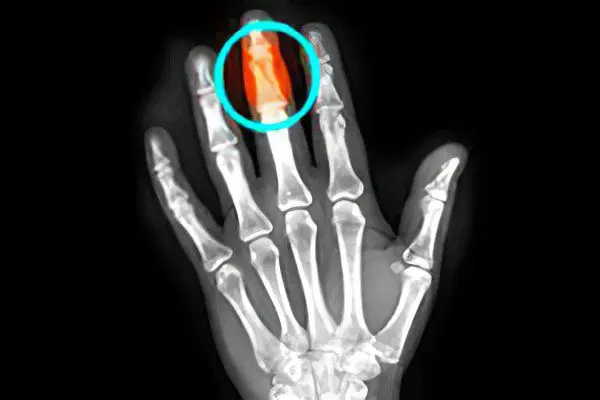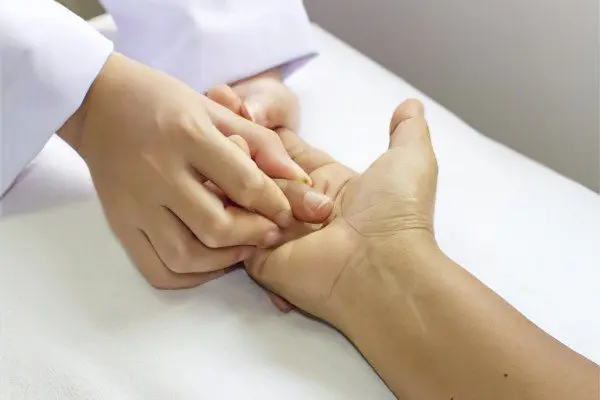Contents
Each finger of the hand consists of three tubular bones, or phalanges: the nail, middle and main, with the exception of the thumb, which has two. A finger fracture should not be taken as a minor injury, since without adequate treatment it can have certain negative consequences: restrictions in finger flexion, pain even with light loads, reduced grip strength.
Fractures of the finger phalanges are a fairly common injury, the frequency of which is about 5% of all recorded fractures. The nail phalanx of the index finger is most often damaged, in 29% of cases multiple fractures are observed.
Causes of fractures of the phalanges of the fingers
Usually, a fracture occurs as a result of a direct injury (domestic, industrial, sports), a heavy object falling on the hand or a bruise, in more rare cases, due to excessive extension or twisting of the fingers.
Symptoms of a fracture of the phalanx of the finger

The main signs of a fracture include:
Pain of a aching nature, which spreads to the entire finger, can be given to the hand, arm to the elbow and is aggravated by touch and palpation;
Edema at the fracture site;
Subcutaneous hemorrhage and hematoma formation;
Restriction of movements – a characteristic feature is the impossibility of complete extension of the broken finger, which is well detected when laying the palms on the table: the damaged finger will not adhere to the surface of the table;
Finger deformity.
A broken finger can be combined with a dislocation of the joints, damage to the tendons or ligaments. Injuries of 2-5 fingers do not have big differences among themselves. A broken thumb is easily confused with a bruise or dislocation. Most often, its main phalanx is damaged.
In case of a fracture with a displacement, in addition to pain and hemorrhage, there is a noticeable deformation (lengthening or shortening of the finger), pathological mobility, the inability to make active movements, for example, to clench the hand into a fist. Any of these signs indicate a fracture. The diagnosis of a non-displaced fracture presents significant difficulties, and x-rays are required to confirm it.
Diagnostics
If there are signs of a fracture, an x-ray of the finger is performed in two projections to determine the location of the fracture and its type. A phalanx fracture can be transverse, spiral or comminuted, in the latter case crepitus is noted (crunching of fragments on palpation).
Significant difficulty is the diagnosis of fractures without displacement, cracks and intra-articular fractures.
Treatment of a fracture of the phalanx of the fingers
If there is no displacement and the joint is not affected, conservative treatment is applied. The damaged fragment of the finger is fixed with a plaster splint or polymer bandage. An adjacent finger can be used as a splint.
If there is displacement, but the fracture is not considered unstable, it can be repaired without surgery under local anesthesia. After that, the pallet is fixed in the same way. A fracture of the phalanx usually grows together in 3-4 weeks. During this time, follow-up x-rays are taken to make sure the bones are properly fused.
If the fracture is unstable, the articular surfaces are affected, the fragments are displaced and there is a strong deformity, a surgical operation (osteosynthesis) is necessary to restore the correct anatomy of the hand. For this, an open reposition of bone fragments is performed: an incision is made to gain access to the fracture site, the fragments are compared and fixed using metal structures – knitting needles, plates, screws. The wound is sutured and closed with a sterile bandage, the sutures are removed after two weeks. The advantages of this method include guaranteed restoration of the anatomy of the finger, the possibility of its early development; to the minuses – a small residual scar.
If the victim does not agree to the operation, then titanium wires are introduced through the skin. The advantages of this method include the simplicity and speed of the procedure, the absence of an incision and a subsequent scar. The disadvantages are the likelihood of infection of the fracture area, since the end of the needle remains outside, prolonged wearing of gypsum (up to 1 month), the impossibility of early development of the finger, which may result in irreversible contracture (limitation of passive movements in the joint).
How to develop a finger after a fracture?

The performance of the hand will depend on the full restoration of the functions of the fingers. The rehabilitation program is compiled together with the attending physician. To develop fingers should begin immediately after removing the plaster. Additionally, physiotherapy and massage are prescribed. You can also perform these exercises with intact fingers of both hands from 2-3 days after the injury.
Put your hands on the table with your palms, tear your fingers off the table surface alternately and together;
Being in the same position, reduce and spread your fingers;
Make circular movements with fingertips on the surface of the table, clockwise and counterclockwise;
Raise the hands and in the air consistently bring together and spread the fingers, gradually increasing the pace;
Gather your fingers into a “pinch” and relax; can be done on the table and in the air;
With each finger, reach the tip of the thumb, folding them in the form of a ring;
Bend alternately 2-5 fingers, while the 1st finger is retracted to the side;
Clench your fingers into a fist, and then sharply straighten them. This exercise is very effective when done in warm water (about 38°C).
Also useful:
Pour 2 different cereals on the table, mix them, and then sort through;
Sort out the rosary;
Collect children’s designer;
Work at the keyboard;
Use carpal expander;
Just knead your fingers with your healthy hand.
All exercises are recommended to be performed 10-15 times, 3-4 sets per day. It is good to make them in warm water, after dissolving sea salt in it. After charging, you can rub anti-inflammatory ointment.









